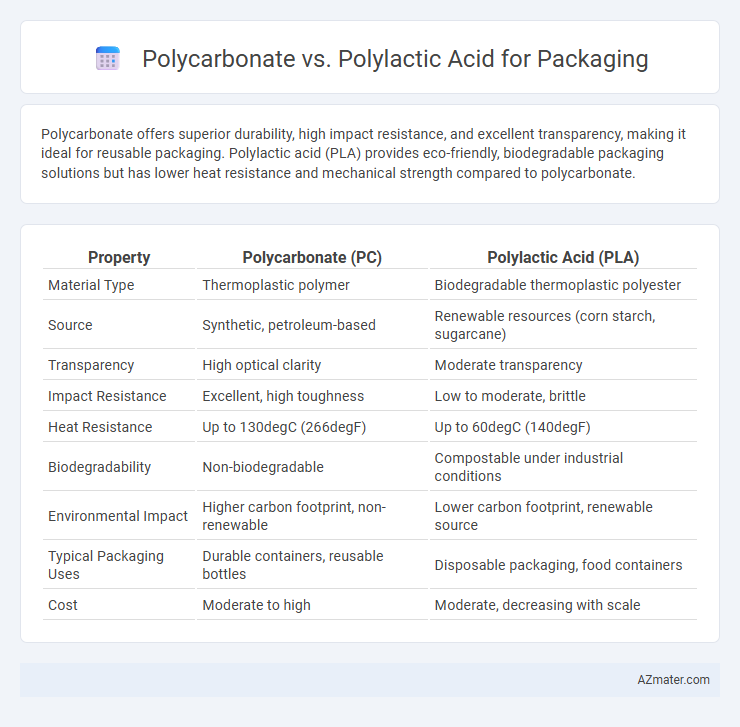Polycarbonate offers superior durability, high impact resistance, and excellent transparency, making it ideal for reusable packaging. Polylactic acid (PLA) provides eco-friendly, biodegradable packaging solutions but has lower heat resistance and mechanical strength compared to polycarbonate.
Table of Comparison
| Property | Polycarbonate (PC) | Polylactic Acid (PLA) |
|---|---|---|
| Material Type | Thermoplastic polymer | Biodegradable thermoplastic polyester |
| Source | Synthetic, petroleum-based | Renewable resources (corn starch, sugarcane) |
| Transparency | High optical clarity | Moderate transparency |
| Impact Resistance | Excellent, high toughness | Low to moderate, brittle |
| Heat Resistance | Up to 130degC (266degF) | Up to 60degC (140degF) |
| Biodegradability | Non-biodegradable | Compostable under industrial conditions |
| Environmental Impact | Higher carbon footprint, non-renewable | Lower carbon footprint, renewable source |
| Typical Packaging Uses | Durable containers, reusable bottles | Disposable packaging, food containers |
| Cost | Moderate to high | Moderate, decreasing with scale |
Introduction to Polycarbonate and Polylactic Acid
Polycarbonate is a durable, impact-resistant thermoplastic widely used in packaging for its clarity and strength, enabling secure protection of sensitive products. Polylactic acid (PLA) is a biodegradable thermoplastic derived from renewable resources like corn starch, gaining popularity in environmentally friendly packaging applications. Both materials offer distinct advantages, with polycarbonate excelling in durability and PLA in sustainability and compostability for packaging solutions.
Chemical Structure and Composition
Polycarbonate, a synthetic polymer derived from bisphenol A and phosgene, features a rigid aromatic carbonate group that provides high impact resistance and thermal stability in packaging applications. Polylactic acid (PLA), a biodegradable aliphatic polyester synthesized from renewable resources like corn starch or sugarcane, exhibits a simpler linear structure with ester linkages that influence its compostability and lower thermal tolerance. The distinct chemical compositions determine polycarbonate's durability and reusability while enabling PLA's eco-friendly degradation and suitability for short-lifecycle packaging.
Manufacturing Processes Compared
Polycarbonate packaging involves injection molding or extrusion processes that require high temperatures and specialized equipment, enabling the production of durable, impact-resistant containers ideal for reusable applications. Polylactic acid (PLA) packaging is typically manufactured through extrusion or thermoforming at lower temperatures, benefiting from PLA's biodegradable properties and compatibility with composting facilities. While polycarbonate offers superior mechanical strength and thermal resistance, PLA emphasizes eco-friendly manufacturing with lower energy consumption and reduced carbon footprint.
Environmental Impact and Sustainability
Polycarbonate (PC) is a petroleum-based plastic known for its durability and excellent barrier properties but poses environmental challenges due to its non-biodegradable nature and reliance on fossil fuels. Polylactic acid (PLA) is a bioplastic derived from renewable resources like corn starch, offering biodegradability and compostability under industrial conditions, making it a more sustainable option for packaging. The environmental impact of PLA is generally lower than PC, with reduced carbon emissions and less persistent waste, but PLA's performance limitations and composting infrastructure availability influence its practical sustainability.
Mechanical Properties and Durability
Polycarbonate exhibits superior mechanical strength and impact resistance compared to polylactic acid, making it more suitable for durable packaging applications. Polylactic acid, a biodegradable polymer derived from renewable resources, has lower tensile strength and is more susceptible to degradation under environmental stress. The long-term durability of polycarbonate outperforms PLA, especially in environments requiring repeated handling and exposure to temperature variations.
Barrier Properties for Packaging
Polycarbonate (PC) exhibits superior barrier properties compared to polylactic acid (PLA), with significantly lower oxygen transmission rates (OTR) and moisture vapor transmission rates (MVTR), making it ideal for packaging sensitive products that require extended shelf life. PLA, derived from renewable resources, offers moderate barrier capabilities but tends to be more permeable to gases and moisture, limiting its use in high-barrier packaging applications. Enhanced barrier formulations and coatings are often needed to improve PLA's performance, whereas polycarbonate's inherent structure provides robust protection without additional treatments.
Safety and Food Contact Regulations
Polycarbonate offers high durability and heat resistance, making it suitable for repeated food contact under FDA and EU food safety regulations, but concerns about BPA leaching have led to increased scrutiny and regulatory restrictions. Polylactic acid (PLA), derived from renewable resources, is biodegradable and generally recognized as safe (GRAS) by regulatory agencies, with excellent compliance for food contact applications, but its lower heat resistance limits use in hot food packaging. Both materials meet key food contact standards, but choosing between them depends on specific safety profiles, environmental considerations, and regulatory compliance for end-use conditions.
Cost Analysis and Market Availability
Polycarbonate offers high durability and clarity for packaging but is generally more expensive due to its complex manufacturing processes and raw material costs, limiting its widespread market availability compared to polylactic acid (PLA). Polylactic acid derives from renewable resources like corn starch, providing a cost-effective and sustainable alternative with growing market presence due to increasing consumer demand for eco-friendly packaging. Despite PLA's lower heat resistance and mechanical strength, its affordability and biodegradability make it dominant in biodegradable packaging markets, while polycarbonate remains preferred for specialized, high-performance applications.
End-of-Life: Recycling and Biodegradability
Polycarbonate (PC) is a durable, recyclable thermoplastic widely utilized in packaging, recyclable through established industrial processes that enable material recovery and reuse, although recycling infrastructure varies by region. Polylactic acid (PLA) is a bioplastic derived from renewable resources like corn starch, featuring compostability and biodegradability under industrial composting conditions, but it requires specific facilities to break down effectively. PLA's biodegradability and renewable origin make it an environmentally favorable end-of-life option compared to PC, which relies on mechanical recycling and may persist longer in landfills if not properly processed.
Choosing the Right Material for Packaging Applications
Polycarbonate offers high impact resistance, clarity, and thermal stability, making it ideal for durable, reusable packaging requiring transparency and toughness. Polylactic acid (PLA), a biodegradable bioplastic derived from renewable resources, suits eco-friendly, compostable packaging with moderate strength and clarity. Selecting between polycarbonate and PLA depends on balancing durability and environmental impact, with polycarbonate favored for long-term use and PLA preferred for sustainable, single-use applications.

Infographic: Polycarbonate vs Polylactic acid for Packaging
 azmater.com
azmater.com